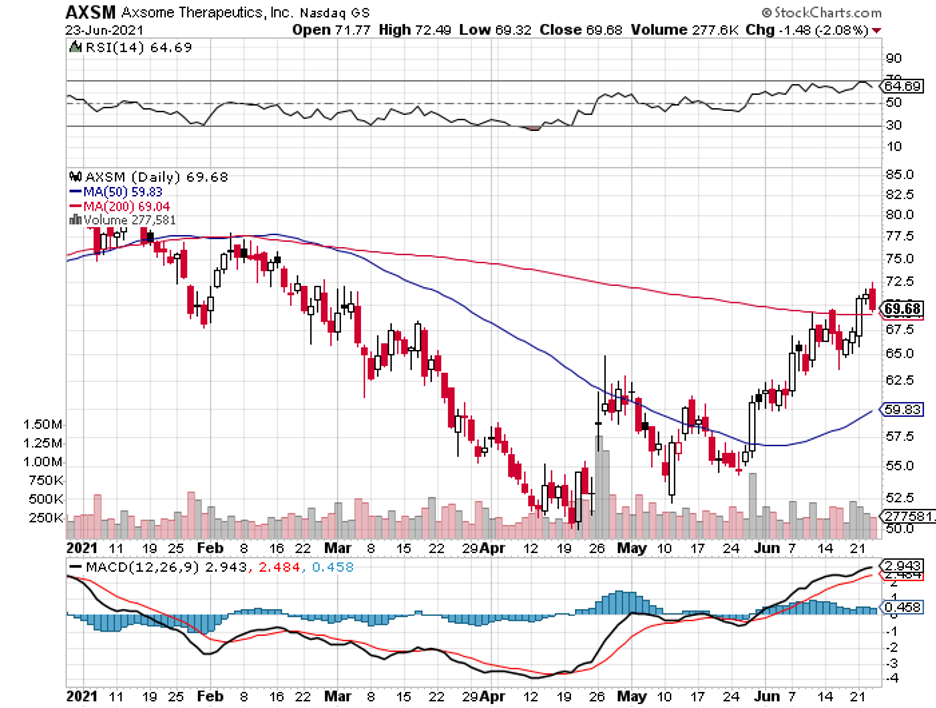Biotechnology companies are known as the riskiest investments in the stock market. More often than not, they are small, cash-strapped, and with futures so closely tied up to the success or failure of a single clinical study.
For each Amgen (AMGN), which exploded from a market capitalization of less than $1 billion roughly 30 years ago to a whopping $137.15 billion today, there are thousands that fail and fall into obscurity.
However, when a biotech makes it big, the rewards can be transformative—and this speckle of hope is what makes this industry incredibly exciting and interesting.
Let’s take Axsome Therapeutics (AXSM) as an example.
This stock has been beaten down, but its pipeline programs still hold the potential to inflate the portfolios of its shareholders if their science proves to be successful.
Actually, things appear to be turning around for Axsome these days.
Focused on developing novel and innovative treatments for central nervous system disorders, Axsome’s stock price recently enjoyed a 13% climb thanks to the latest development on one of its pipeline candidates: AXS-14.
AXS-14, which is a fibromyalgia treatment, should be ready for submission by the fourth quarter of 2022.
Looking at the potential target market for this drug, its estimated peak sales are somewhere in the range between $500 million to $1 billion.
Another promising treatment in Axsome’s pipeline is its novel migraine medication, AXS-07, which showed great efficacy results in its Phase 3 trial.
In addition, 74% of patients who took AXS-07 experienced no pain progression from two to 24 hours since taking the medication, with almost 50% of them no longer needing rescue medication.
Given the remarkable results for AXS-07, Axsome plans to submit it for a new drug application in the first half of 2021. In fact, this candidate has shown better results than the current gold standard, Merck’s (MRK) Maxalt.
If approved, this migraine treatment can reach peak sales from half a billion to over $1 billion in the United States alone.
However, the most promising candidate in Axsome’s pipeline is its treatment for major depressive disorder (MDD), AXS-05, which recently received priority review from the US FDA.
If things go as planned, the company plans to submit it for review by August 22 this year.
This drug is also a frontrunner medication for Alzheimer’s Disease (AD) Agitation.
On top of these, its Phase 3 clinical trial of AXS-05 showed that it significantly improved the symptoms of people suffering from depression.
Beyond these conditions, Axsome is also looking into using AXS-05 as treatment for migraines, smoking cessation, and even migraines.
AXS-05 has a massive addressable market, with roughly one-third of the 17 million adults in the US suffering from MDD. This could mean peak sales for this indication alone at $4 billion.
While Axsome still has other promising treatments in its pipeline, these three late-stage candidates clearly indicate a very high ceiling.
All of them have the capacity to reach blockbuster status once approved.
At this point and looking at its recent earnings report, Axsome recorded a cash balance of $164 million. It also still has some money left from its $225 million loan, which means the company can still sufficiently fund its operations and continue with its research into at least 2024.
Considering the timeline it has for the three candidates in its pipeline, it’s reasonable to assume that it can generate sales before that date.
All in all, they could rake in a total of at least $8 billion in sales annually for Axsome—a lucrative leap considering that the company currently only has $2.62 billion in market capitalization.
Given its vast pipeline, host of successful trials thus far, and near-term catalysts, I say this clinical-stage biotech’s lowered prices offer a cautious buying opportunity for investors with a penchant for risks.


